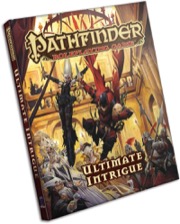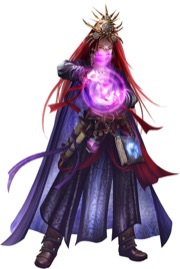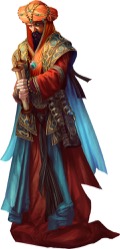The Most Intriguing Classes
Wednesday, March 10, 2016
Pathfinder Roleplaying Game: Ultimate Intrigue is only a few weeks away, and it's time for the first rules preview blog—this time focusing on classes!
The new class in Ultimate Intrigue is the vigilante. An upstanding member of society by day and adventurer by night, the vigilante has two different identities which can even have different alignments. Unless someone discovers that the two identities are the same, divinations like scrying only work when the vigilante is in the form the diviner is trying to scry. Each vigilante chooses to be either a stalker, focusing on sneaking up on foes and punishing them before the foe notices the stalker is there, or the avenger, focusing on giving foes a more straightforward beatdown and gaining a full base attack bonus. The vigilante class is extremely modular, with a talent option at every level, switching off between social talents that give him an edge in social situations and other intrigue hijinks out of combat, and vigilante talents, which generally provide powerful combat options that he can use in either identity, though it might give him away if people see him using them in his social identity.
If you've been with us since the playtest, the biggest change is that zealot and warlock are now archetypes, and while avenger and stalker each have some talents that only that specialization can choose, many of the talents that seemed like they fit the vigilante in general are now available to all vigilantes, as you requested in the playtest. Also, you asked for social talents based on being a craftsman or professional, and those are now available as well!
So I mentioned that warlock and zealot (which were arcane and divine vigilantes for those of you not part of the playtest) are now archetypes. All told, the vigilante has 10 pages of archetypes, the most that any class has ever received in a book. After all, he has plenty of catch-up in order to match his older cousins that have been around for more books. The brute has a hulking out-of control vigilante identity, and he can't always stop the transformation when he's in danger. Cabalists make blood pacts with dark patrons, gaining witch spells, blood powers, and a familiar. Gunmasters bring justice with firearms, and they gain a bunch of deeds as potential vigilante talents. The magical child archetype covers the "magical girl" trope, with a transformation sequence ability (faster switch between identities, but with flashy lights and music), summoner spells, and an otherworldly buddy. Mounted furies are mounted vigilantes like Zorro whose steeds also have a secret identity. Psychometrists are gadgetmasters and tinkerers who create personal occult gadgets to do things like fly (basically creating gadgets that each perform a single occultist focus power). Warlocks, are arcane casters from the magus list, with elemental options and mystic bolts of energy. Wildsouls are vigilantes who gain animalistic features in their vigilante identity. Finally, zealots are secret champions of their faiths, often because their religion is outlawed or persecuted, who cast from the inquisitor list and smite foes of one opposing alignment.
But vigilantes aren't the only ones with archetypes. Exciting archetypes for other classes include the tyrant (a lawful evil antipaladin archetype!), cardinal (a politics-heavy cleric with 6 skill points per level), gray paladin (can be one step from lawful good and smite any foe, but the lack of absolute conviction makes many abilities less absolute), fey caller (unchained summoner that summons a fey, with an all-new fey eidolon), zeitgeist binder (spiritualist that calls in a local zeitgeist based on a settlement statistic like corruption or society), battle scion (Celt/King Arthur blend skald that can call others to a quest and go into a deathlike sleep to return some day), dandy (a courtly ranger with the ability to manipulate rumors instead of wild empathy), vizier (a mesmerist that has a "power behind the throne" ability to make it look like his allies are the real threat while insidiously influencing them for his own agenda), feyspeaker (a fey-themed druid with 6 skill points per level that casts using Charisma!), and plenty more. In addition, the classes chapter two new inquisitions (Crime and Secrets), three new ranger combat styles (deceptive, menacing, and underhanded), four new rogue talents (follow along, shades of gray, hidden mind, and stalker talent), an oracle mystery (Intrigue), and even five intrigue-themed kineticist utility wild talents (earthmeld, flame trap, spying touchsight, greater voice of the wind, and greater watersense).
Tune in next week to hear more about some of the cool feats, spells, and magic items of intrigue!
Mark Seifter
Designer
We have updated our Privacy Policy.
Paizo.com uses cookies. You can block paizo.com from using cookies within your browser settings, but doing so will hinder site functionality.
More information can be found in our Privacy Policy.


